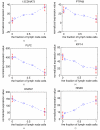In silico microdissection of microarray data from heterogeneous cell populations
- PMID: 15766384
- PMCID: PMC1274251
- DOI: 10.1186/1471-2105-6-54
In silico microdissection of microarray data from heterogeneous cell populations
Abstract
Background: Very few analytical approaches have been reported to resolve the variability in microarray measurements stemming from sample heterogeneity. For example, tissue samples used in cancer studies are usually contaminated with the surrounding or infiltrating cell types. This heterogeneity in the sample preparation hinders further statistical analysis, significantly so if different samples contain different proportions of these cell types. Thus, sample heterogeneity can result in the identification of differentially expressed genes that may be unrelated to the biological question being studied. Similarly, irrelevant gene combinations can be discovered in the case of gene expression based classification.
Results: We propose a computational framework for removing the effects of sample heterogeneity by "microdissecting" microarray data in silico. The computational method provides estimates of the expression values of the pure (non-heterogeneous) cell samples. The inversion of the sample heterogeneity can be facilitated by providing accurate estimates of the mixing percentages of different cell types in each measurement. For those cases where no such information is available, we develop an optimization-based method for joint estimation of the mixing percentages and the expression values of the pure cell samples. We also consider the problem of selecting the correct number of cell types.
Conclusion: The efficiency of the proposed methods is illustrated by applying them to a carefully controlled cDNA microarray data obtained from heterogeneous samples. The results demonstrate that the methods are capable of reconstructing both the sample and cell type specific expression values from heterogeneous mixtures and that the mixing percentages of different cell types can also be estimated. Furthermore, a general purpose model selection method can be used to select the correct number of cell types.
Figures








References
-
- Golub T, Slonim D, Tamayo P, Huard C, Gaasenbeek M, Mesirov J, Coller H, Loh M, Downing J, Caligiuri M, Bloomfield C, Lander E. Molecular classification of cancer: class discovery and class prediction by gene expression monitoring. Science. 1999;286:531–537. doi: 10.1126/science.286.5439.531. - DOI - PubMed
-
- van't Veer LJ, Dai H, van de Vijver MJ, He YD, Hart AA, Mao M, Peterse HL, van der Kooy K, Marton MJ, Witteveen AT, Schreiber GJ, Kerkhoven RM, Roberts C, Linsley PS, Bernards R, Friend SH. Gene expression profiling predicts clinical outcome of breast cancer. Nature. 2002;415:530–536. doi: 10.1038/415530a. - DOI - PubMed
-
- Zhang W, Ramdas L, Shen WP, Song WS, Hu L, Hamilton SR. Apoptotic response to 5-fluorouracil treatment is mediated by reduced polyamines, non-autocrine fas ligand and induced tumor necrosis factor receptor 2. Cancer Biol Ther. 2003;2:572–578. - PubMed
-
- Zhang W, Shmulevich I, Astola J. Microarray Quality Control. John Wiley and Sons; 2004.
Publication types
MeSH terms
Substances
LinkOut - more resources
Full Text Sources

